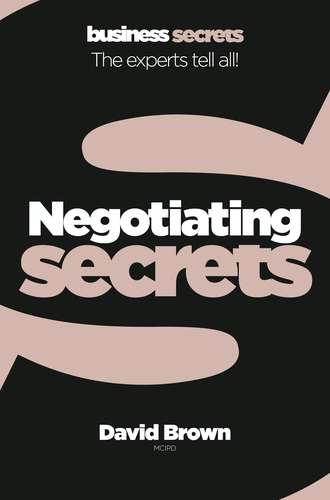
Полная версия
Negotiating
2.1 Plan your approach
A clear understanding of your objectives is essential when negotiating. You should be ready to propose a package that is challenging but credible. Your preparation should end with you deciding on your ‘Desirable’ list and using it to form the basis of your first proposal. Use these steps to prepare.
1 List the things on which you can give and take. These are called your negotiating variables. If it is possible to give and take on something, list it as a variable.
2 For each variable, list the ‘Desirable’ (best you can hope for), ‘Probable’ (most likely) and ‘Worst’ (worst that you would want to finish up with) outcome from your point of view.
3 Put a value on the difference between ‘Desirable’ and ‘Worst’. Now you have identified what the most valuable items are from your point of view. Price and volume are obvious values, but sometimes it is more difficult to put a value on a variable.
4 List all those things on which you are not prepared to give and take. You are effectively saying they are non-negotiable.
5 Look at everything done so far from the point of view of the other party. Ask yourself what they will be looking for on each variable – and what variables they will be looking at.
6 Consider where you will have areas of agreement, and where there will be disagreement. If your partner wants to negotiate on the things that you have considered to be non-negotiable, you may struggle to reach agreement.
7 Having weighed up the situation, you should be prepared to propose your first package (see chapter 4) as the ‘Desirable’ set of objectives, although the Discussion (chapter 3) may cause you to modify your first proposal.
Example list of negotiating variables
This table shows how selling a family business looked when listed in the way described. Your preparation will always give you maximum support if you finish up with this sort of five-column table.
Negotiating variable Desirable Probable Worst Likely difference in value desirable to worst Basic price (for 100%) £5.1m £4.7m £4.5m £600,000 Keep a family stake 30% 20% 10% £1m Retain directors Father = MDSon = Prod Dir Father retiresSon = Prod Dir Both retire Pride and/orrenumeration Pay directors 2 years at£30k each 1 year at £30k Nil £120,000 Retain staff Maintain statusquo for 6 months 3 months’notice clause 3 months’notice clause Loyalty Payment terms 100% now 50% now50% two months 100%two months Securityand interestPrepare a detailed list of variables and assess their importance to both parties.
2.2 Anticipate the other party’s approach
In your preparation, it is important to consider the likely reaction of the other side (your negotiating partner). There is a need to display empathy – to put yourself in the other person’s shoes.
You are not negotiating in a vacuum. You have to work out an agreement with other people, who have their own objectives, problems and emotions! Here are some of the things to consider:
Priorities. What’s important to them is what has the most value to them. So it is important to be aware of their likely gap between ‘Desirable’ and ‘Worst’. You can’t be sure of this until the discussion stage, but you can think about relative importance as they will see it.
case study A buyer is negotiating the purchase of a batch of components for a machine. The buyer’s position is as follows: ‘Best’ price £6.44 each; ‘Worst” price £7.37. The seller’s position is: ‘Best’ price £7.80 each; ‘Worst” price £6.80. Here the negotiating issue is price. Somewhere between ‘Desirable’ and ‘Worst’ limits is a potential negotiated settlement for both parties. The area of overlap is a price between £6.80 and £7.37. If there is no overlap on another issue (say, payment terms) there would be a potential disagreement and failure to agree. This will only be overcome by one or both parties being flexible.
“If you are to put on another man’s shoes you must first take off your own”
Mark Twain, American author
Wants. You need to consider ‘wants’. What they want and what you want. ‘Wants’ are crucial in any negotiation because you trade/exchange what they want with something that you have.
Monkeys. Does the other party have any serious ‘monkeys on their back’ – things that restrict their ability to move and to be flexible? If they have, you need to understand this, bring it into the open, and help them understand why this is a barrier to both. (I often find companies make credit terms non-negotiable. This can be a real obstacle to agreement, and movement on this issue need not be expensive.)
Behaviour. On every aspect of the negotiation keep asking yourself “How should I behave?” and “How will they behave?” Only then, for example, can you make a good decision about whether your ‘Desirable’ package is the appropriate place to start. And only then will you be ready for their ‘Desirable’ package.
When you prepare, put yourself in the other party’s shoes as well as considering your own position.
2.3 Use a framework to guide you
From your preparation in 2.1 you have a framework which tells you how many variables you have – how many items there are on which you can give and take. You have an idea of what are the most important items to you and to the other party.
Use your framework throughout the negotiation, to allow you to control the result. Here are some of the ways you can do this:
1 Focus early discussions on the variables you are more likely to agree on. This sets a constructive tone, but does not mean you agree on one or two items – see 4.5 ‘Don’t get salami-ed’.
case study I helped in a negotiation that involved providing consignment stocks of fans for a customer building air-conditioning units (consignment stocks are buffer stocks, usually held on a customer’s premises, but only invoiced when the customer draws the stock out). On the face of it, the variables on which we could give and take were the number of items, the quantity, the price and payment terms. The more we prepared, however, the more variables we identified – the period of the agreement, obsolete stock/write off arrangements, carriage, currency changes, insurance costs, ownership of goods, and how to control damage. We considered the value of each of these variables, and this allowed us to negotiate with confidence.
2 You have identified the most valuable variables. Use this framework to calculate the value of any concession that you might be about to make.
3 Use the framework to assess the cost of concessions on one variable with the cost of concessions in another area.
4 Use your framework to decide whether you will hold back discussion on any of your variables. In other words, hold back on one item and use it as one of your final cards when you are wanting to come together and agree.
5 When you negotiate, be prepared to use this framework to re-assess what variables are most important to your negotiating partner. Remember, you want to do repeat business with them.
6 Be ready to use your framework to assess the value of any new variable that crops up in the negotiating process.
Don’t leave your preparation at home! Build on your prepared framework throughout the negotiation.
2.4 Decide on the most important issues
We have already considered the importance of preparation and using that preparation to carry you to a successful conclusion. You now need to be absolutely clear about what is important both to you and to the other party.
The case study below illustrates how the importance of an issue can be assessed – and re-assessed. The crux of the negotiation is the realization that a ‘principle’ that at first seems so important that it is non-negotiable turns out to be nothing of the kind.
case study A UK-based supplier of weighing machines wanted to expand into France with a new system targeted at bakeries. They were in discussion with an agent who wanted exclusive rights to sell the product into the French market. This exclusivity was very important to the agent. Unfortunately, the chairman of the UK company always refused to consider giving exclusive rights to anybody on anything. To him it was a principle. The UK company was not geared up to sell to French bakeries, so there was a stalemate. Through the sales manager, common sense prevailed. The chairman was persuaded that what was ‘important’ to him was not important at all. The agent was given exclusivity for three years based on delivering a certain amount of business, and both parties benefited from the relationship.
Конец ознакомительного фрагмента.
Текст предоставлен ООО «ЛитРес».
Прочитайте эту книгу целиком, купив полную легальную версию на ЛитРес.
Безопасно оплатить книгу можно банковской картой Visa, MasterCard, Maestro, со счета мобильного телефона, с платежного терминала, в салоне МТС или Связной, через PayPal, WebMoney, Яндекс.Деньги, QIWI Кошелек, бонусными картами или другим удобным Вам способом.








